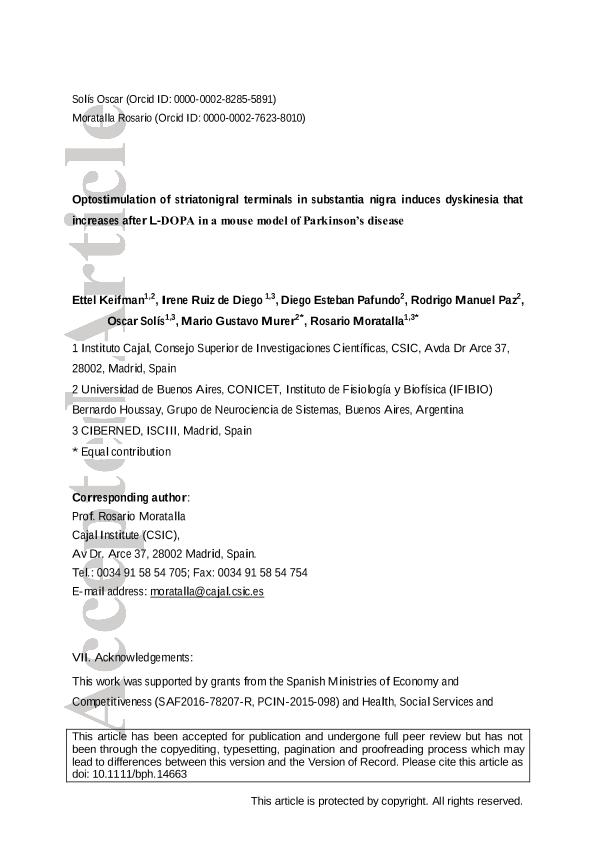Artículo
Optostimulation of striatonigral terminals in substantia nigra induces dyskinesia that increases after L‐DOPA in a mouse model of Parkinson's disease
Keifman, Ettel ; Ruiz De Diego, Irene; Pafundo, Diego Esteban
; Ruiz De Diego, Irene; Pafundo, Diego Esteban ; Paz, Rodrigo Manuel
; Paz, Rodrigo Manuel ; Solís, Oscar; Murer, Mario Gustavo
; Solís, Oscar; Murer, Mario Gustavo ; Moratalla, Rosario
; Moratalla, Rosario
 ; Ruiz De Diego, Irene; Pafundo, Diego Esteban
; Ruiz De Diego, Irene; Pafundo, Diego Esteban ; Paz, Rodrigo Manuel
; Paz, Rodrigo Manuel ; Solís, Oscar; Murer, Mario Gustavo
; Solís, Oscar; Murer, Mario Gustavo ; Moratalla, Rosario
; Moratalla, Rosario
Fecha de publicación:
03/2019
Editorial:
Wiley Blackwell Publishing, Inc
Revista:
British Journal of Pharmacology
ISSN:
0007-1188
Idioma:
Inglés
Tipo de recurso:
Artículo publicado
Clasificación temática:
Resumen
Background and Purpose: L-DOPA-induced dyskinesia (LID) remains a major complication of L-DOPA therapy in Parkinson's disease. LID is believed to result from inhibition of substantia nigra reticulata (SNr) neurons by GABAergic striatal projection neurons that become supersensitive to dopamine receptor stimulation after severe nigrostriatal degeneration. Here, we asked if stimulation of direct medium spiny neuron (dMSN) GABAergic terminals at the SNr can produce a full dyskinetic state similar to that induced by L-DOPA. Experimental Approach: Adult C57BL6 mice were lesioned with 6-hydroxydopamine in the medial forebrain bundle. Channel rhodopsin was expressed in striatonigral terminals by ipsilateral striatal injection of adeno-associated viral particles under the CaMKII promoter. Optic fibres were implanted on the ipsilateral SNr. Optical stimulation was performed before and 24 hr after three daily doses of L-DOPA at subthreshold and suprathreshold dyskinetic doses. We also examined the combined effect of light stimulation and an acute L-DOPA challenge. Key Results: Optostimulation of striatonigral terminals inhibited SNr neurons and induced all dyskinesia subtypes (optostimulation-induced dyskinesia [OID]) in 6-hydroxydopamine animals, but not in sham-lesioned animals. Additionally, chronic L-DOPA administration sensitised dyskinetic responses to striatonigral terminal optostimulation, as OIDs were more severe 24 hr after L-DOPA administration. Furthermore, L-DOPA combined with light stimulation did not result in higher dyskinesia scores than OID alone, suggesting that optostimulation has a masking effect on LID. Conclusion and Implications: This work suggests that striatonigral inhibition of basal ganglia output (SNr) is a decisive mechanism mediating LID and identifies the SNr as a target for managing LID.
Palabras clave:
Dyskinesia
,
L-DOPA
,
Substantia nigra
,
Optogenetics
Archivos asociados
Licencia
Identificadores
Colecciones
Articulos(IFIBIO HOUSSAY)
Articulos de INSTITUTO DE FISIOLOGIA Y BIOFISICA BERNARDO HOUSSAY
Articulos de INSTITUTO DE FISIOLOGIA Y BIOFISICA BERNARDO HOUSSAY
Citación
Keifman, Ettel; Ruiz De Diego, Irene; Pafundo, Diego Esteban; Paz, Rodrigo Manuel; Solís, Oscar; et al.; Optostimulation of striatonigral terminals in substantia nigra induces dyskinesia that increases after L‐DOPA in a mouse model of Parkinson's disease; Wiley Blackwell Publishing, Inc; British Journal of Pharmacology; 176; 13; 3-2019; 2146-2161
Compartir
Altmétricas



